隨著自動化和智能化的快速發展,光致軟致動器在軟體機器人等領域有著巨大的應用前景。液晶彈性體(LCE)兼具橡膠的彈性和液晶特性,可以在將其加熱到向列型-各向同性相轉變溫度(Tin)以上發生時發生形變,在降溫到向列型-各向同性相轉變溫度以下時恢復到原來的初始狀態,因此是軟致動器的理想材料。偶氮苯具有可逆的光響應性,含有偶氮苯基團的LCE已經被廣泛應用于光致軟致動器,然而偶氮苯LCE的設計和合成一般比較復雜。在LCE中添加具有較強光熱轉換能力的納米填料是一種賦予LCE光致驅動功能的有效方法。納米填料和LCE的光熱轉換能力以及與LCE的相容性直接影響了軟致動器的機械性能和光致驅動性。開發光熱轉換能力強、與LCE相容性好的納米填料成了制備LCE基光致軟驅動器的關鍵之一。
華南師范大學張振課題組以聚多巴胺(PDA)包覆的MXene和纖維素納米晶(CNC)和(PDA coated MXene and CNC, PMC)為LCE的光熱和增強納米填料,制備了一種具有可精確光調控、優異力學性能的LCE光致軟驅動器。MXene具有優異的光熱轉換能力,被用作光熱納米填料;PDA具有優異的抗氧化性,用于增強MXene的抗氧化穩定性以及MXene與LCE間的相容性;CNC具有優異的分散性能和力學性能,用做分散劑以防止MXene在PDA改性時的團聚以及增強納米填料。本研究制備的PMC-LCE光致軟驅動器具有出色的光熱轉換能力和顯著增強的機械性能(楊氏模量5.0 MPa,拉伸強度20.6 MPa, 斷裂伸長率132.8%),能夠舉起其自身質量1500倍的重物,工作密度(89 kJ m-3)約是哺乳動物骨骼肌的兩倍。通過近紅外光調控、粘膠帶、形狀剪裁、液晶排列設計等,實現了一系列的光致驅動功能,比如爬、走、旋轉以及游泳等。
該成果以Polydopamine coated MXene and cellulose nanocrystal as photothermal and reinforcing nanofiller for liquid crystal elastomer-based light-driven soft actuator為題發表在Journal of Colloid And Interface Science(影響因子9.4,中科院一區,JCR一區)上。該論文的第一作者為周口師范學院朱超勝和華南師范大學楊紹源,通訊作者為華南師范大學張振、南京工業大學褚良永和廣西民族大學藍平,共同作者為南開大學謝偉偉、廣西名族大學藍麗紅、華南師范大學周國富、王蒙恩、曾怡舒等。

Figure 1. Schematic illustration of the fabrication of NIR-light driven LCE based soft actuator with PMC as photothermal and reinforcing nanofiller.
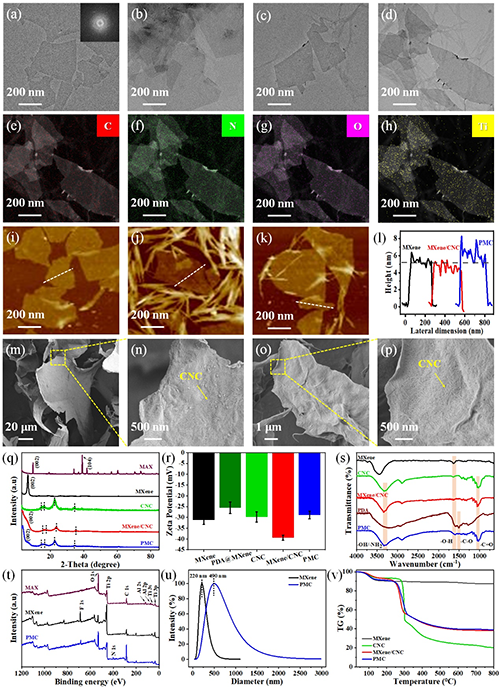
Figure 2. TEM image of (a) MXene, (b) PDA@MXene, (c) MXene/CNC, and (d) PMC. The (e) C, (f) N, (g) O, and (h) Ti elementary mappings of PMC. The AFM images of (i) MXene, (j) MXene/CNC and (k) PMC, and (l) their height morphology. The SEM images of freeze-dried (m & n) MXene/CNC and (o & p) PMC. (q) The XRD patterns of MAX, MXene, CNC, MXene/CNC, and PMC. (r) The zeta potential values of MXene, PDA@MXene, CNC, MXene/CNC, and PMC. (s) The FTIR spectra of MXene, CNC, MXene/CNC, PDA and PMC. (t) The XPS spectra of MAX, MXene, and PMC. (u) DLS results of MXene and PMC. (v) TGA curves of MXene, CNC, MXene/CNC, and PMC.
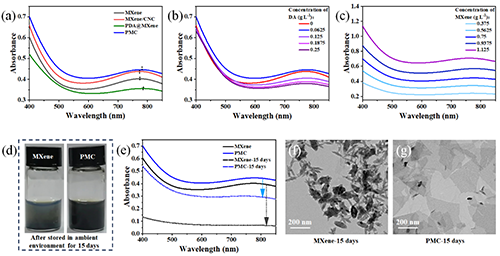
Figure 3. The UV-vis spectra of (a) MXene, MXene/CNC, PDA@MXene, and PMC aqueous dispersion. The UV-vis spectra of PMC dispersion with different concentrations of (b) DA and (c) MXene. The (d) digital images, (e) UV-vis spectra, and TEM images of (f) MXene and (g) PMC dispersion stored in ambient environment for 15 days.
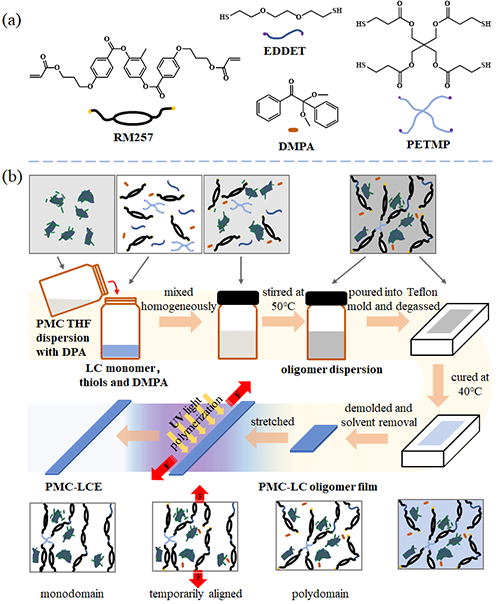
Figure 4. Schematic preparation of PMC-LCE using a two-step thiol–acrylate method. (a) The molecular structures of RM257, EDDET, PETMP, and DMPA. (b) The preparation procedure of PMC-LCE and corresponding schematic states of PMC and LC molecules.
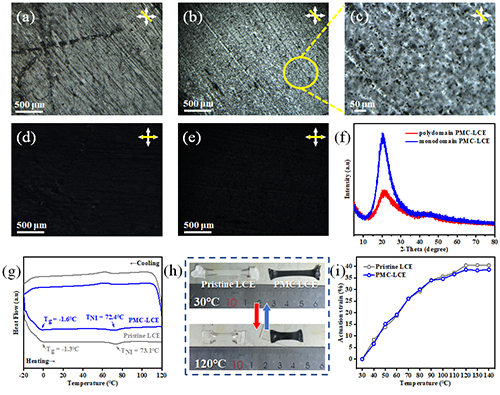
Figure 5. POM images of (a) pristine LCE and (d) its corresponding 45°-rotated LCE. The POM images of (b & c) PMC-LCE at different magnification and (e) its corresponding 45°-rotated PMC-LCE. (f) The XRD patterns of PMC-LCE before (polydomain) and after (monodomain) alignment. (g) DSC curves of pristine LCE and PMC-LCE. (h) The pristine LCE and PMC-LCE at 30℃ to 120℃. (i) The actuation strain of pristine LCE and PMC-LCE as a function of temperature.
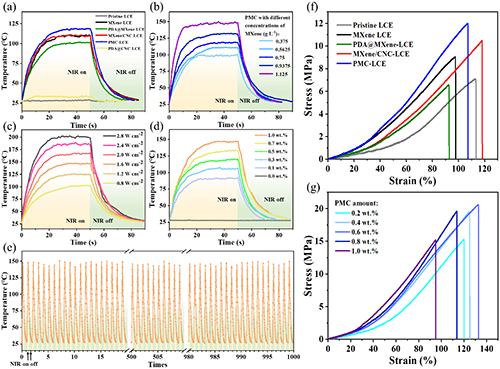
Figure 6. Photothermal conversion and mechanical performance of LCE films. Temperature of LCE under irradiation of 808 nm NIR laser with different (a) kinds of photothermal nanofillers, (b) concentrations of MXene in PMC, (c) NIR intensities, (d) amount of PMC, and (e) for 1000 NIR on-off cycles. Tensile stress-strain curves of LCE with (f) different kinds of nanofiller and (g) different amount of PMC as nanofiller.
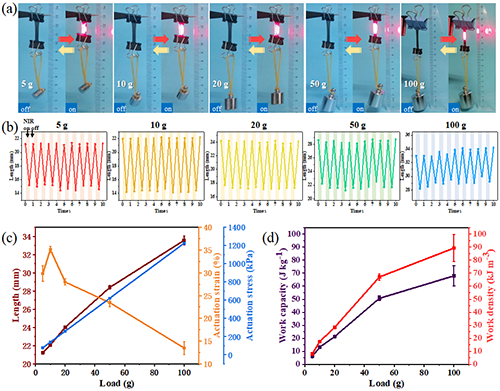
Figure 7. Loads lift testing of PMC-LCE driven by NIR laser at 808 nm at power intensity of 1.5 W. (a) Digital images of PMC-LCE films with NIR laser on or off with loads of different weights. (b) Lengths of PMC-LCE with 10 NIR laser on-off cycles with loads of different weights. (c) Initial lengths of PMC-LCE films before laser on and the actuation strains and stress as a function of loads of different weights. (d) Work capacities and work densities of PMC-LCE with loads of different weights.
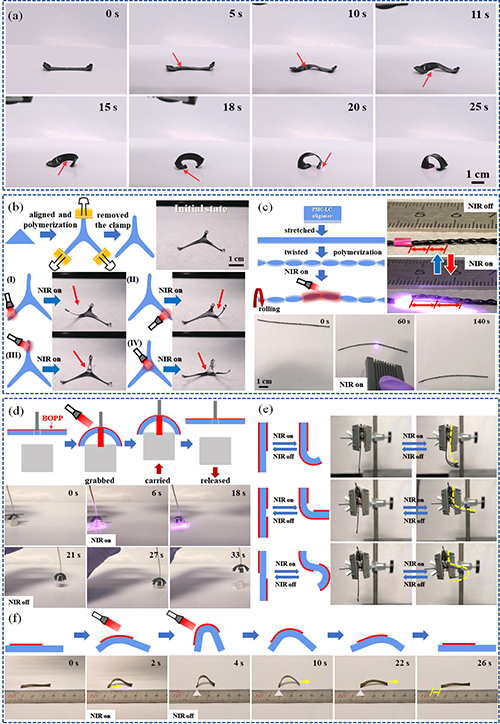
Figure 8. PMC-LCE applied as actuators (the red arrows represented the incident direction of NIR laser). (a) Actuator based on tuning NIR irradiation spot for flat-to-bridge shaped deformation. Actuators based on as-designed alignment with (b) tripod shape and (c) helix structure with rolling function. Actuators based on Janus structure functionalized as (d) soft clamp. (e) The J, L, S shaped actuators programmed from PMC-LCE film and (f) walking actuator.
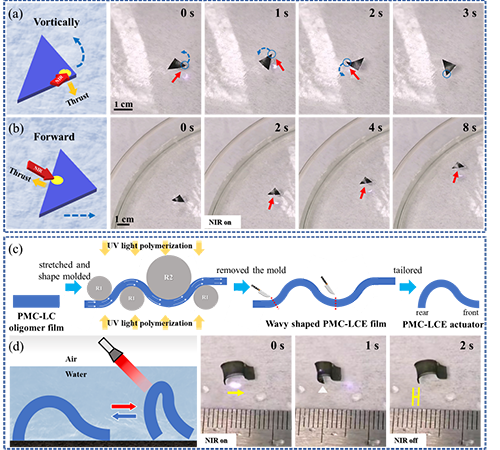
Figure 9. PMC-LCE aquatic actuators. PMC-LCE swimming actuator (a) rotated and (b) moved forward on the water surface with different NIR irradiation spots. (c) Schematic preparation of PMC-LCE underwater walking actuator. (d) The mechanism and images of PMC-LCE actuator walking underwater.
華南師范大學周國富教授團隊張振課題組致力于納米纖維素的綠色制備、表面性能調控、功能材料復合和應用等。通過納米纖維素的綠色制備、表面改性、自組裝和皮克林(Pickering)乳液組裝等,構筑生物可降解、高性能、多功能的納米纖維素基復合材料,并探索其廣泛應用,致力于構建綠色環保、低碳、能源節約型社會。近年來,以一作或通訊作者在Advanced Functional Materials、Chemical Engineering Journal、Journal of Materials Chemistry A、Journal of Colloid And Interface Science、Small、Carbohydrate Polymers、ACS Applied Materials & Interfaces、ACS Sustainable Chemistry & Engineering等期刊發表論文40余篇,論文被引用3200次,H指數32;以第一發明人授權發明專利10項。
原文鏈接:https://doi.org/10.1016/j.jcis.2025.137834
- 四川大學高會樂教授 Adv. Mater.: 小膠質細胞膜包被的聚多巴胺納米遞送系統用于抑郁癥的治療 2025-01-27
- 江南大學王潮霞教授/滑鐵盧大學Yuning Li 教授 ACHM:溫度可視化太陽能面料 - 讓你在冬天保持舒適 2024-12-12
- 江蘇大學鄒小波教授 Coordin. Chem. Rev. 綜述:聚多巴胺涂層在生物分析領域的進展 2024-11-22
- 華南師大張振 Small:纖維素納米晶穩定皮克林乳液法制備高潛熱、熱致變色的相變材料微膠囊及其在智能涂料上的應用 2025-07-09
- 波爾多大學Gilles Sèbe、華南師大張振 Carbohydrate Polymers:皮克林乳液界面SI-ATRP制備兩親性纖維素納米晶 2025-05-19
- 華南師大張振 Small:纖維素納米晶穩定液態金屬Pickering乳液用作光熱、導電直寫墨水 2025-04-25
- 湘潭大學徐圣教授課題組 CEJ:碳微球改性MXene - 一種同時增強聚乳酸材料的阻燃、抑煙和導熱性能的高效雜化阻燃劑 2025-07-15
